| Author |
Message |
|
Harry D.
Location: Los Angeles Joined: 31 Aug 2015
Posts: 12
|
 Posted: Sat 19 Sep, 2015 5:18 pm Post subject: Albion Svante Double Tatami Omote Mat Cutting Party Posted: Sat 19 Sep, 2015 5:18 pm Post subject: Albion Svante Double Tatami Omote Mat Cutting Party |
 |
|
Hi Sword Fans, I bought the Albion Svante from Patrick Kelly ( great Guy, class act, highly recommended) and I thought I would also put it through some cutting tests.. First, I made a stand, according to Tameshigiri Mats, out of Redwood and stained it redwood color. I also used the retaining screw on the oak dowel as recommended here... I made two double omote mat targets -- each tied with 5 pieces of twine. I used the standard "mover's knot" with the loop on the end to get the twine nice and tight.. I threw the pair into the pool for about 15 hours or so..
Here is a video link to the cutting session. I had a great time and the Svante is alot of fun. I really like it... It's the first time I am swinging a sword, so, please forgive the bad form. The sword feels powerful and never vibrates, even in a bad cut... The good cuts feel effortless. I learned one thing... --- Twine can get you a nice souvenir -- Thanks !!
https://youtu.be/5CrKjfG95Oc
https://www.youtube.com/watch?v=5CrKjfG95Oc&feature=youtu.be
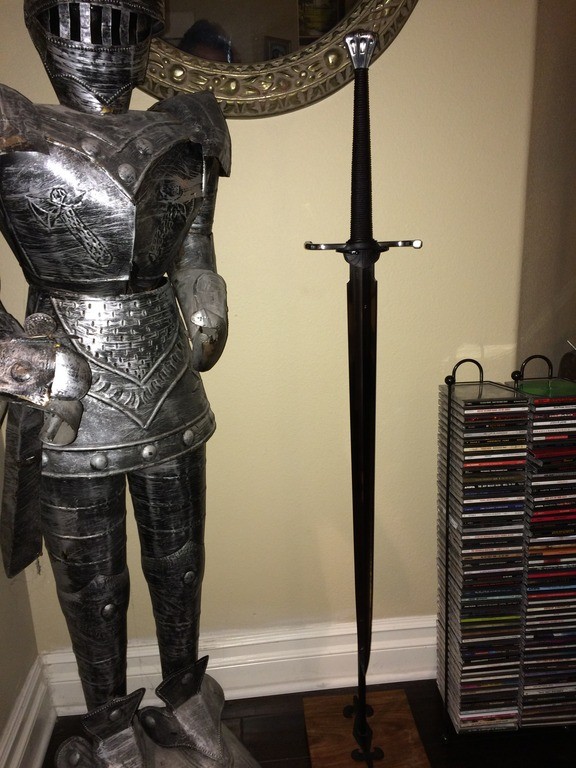
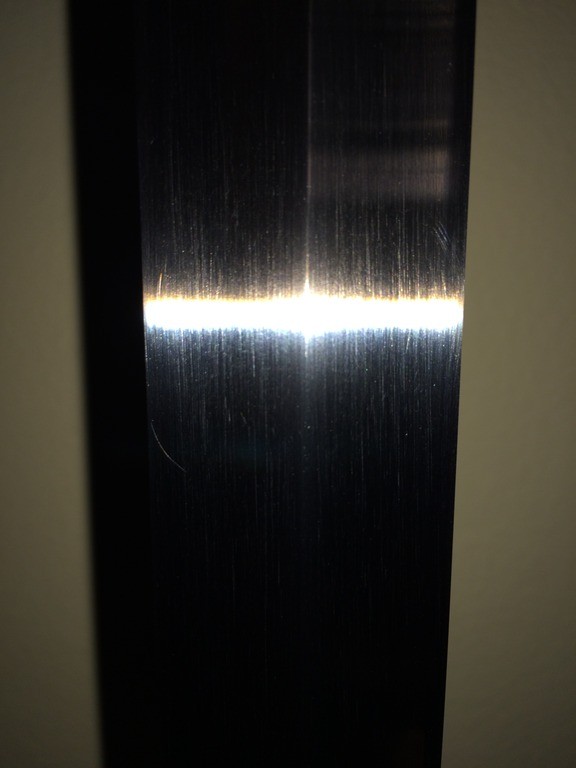
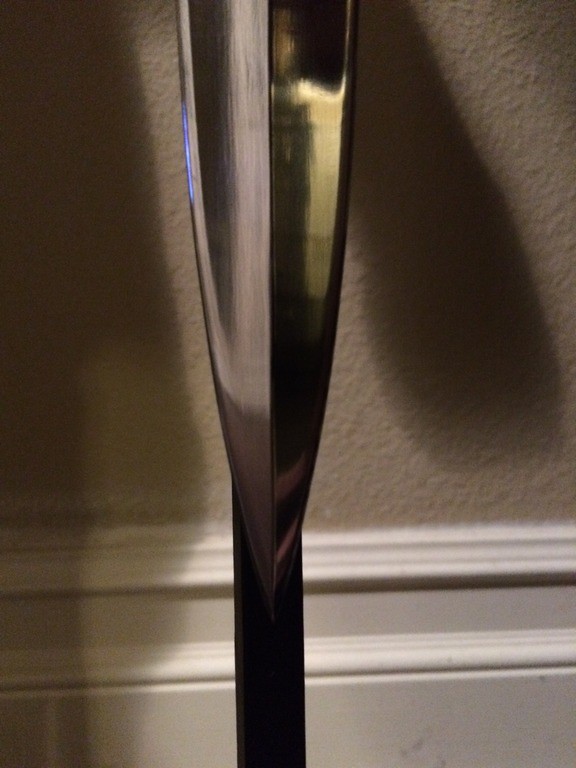
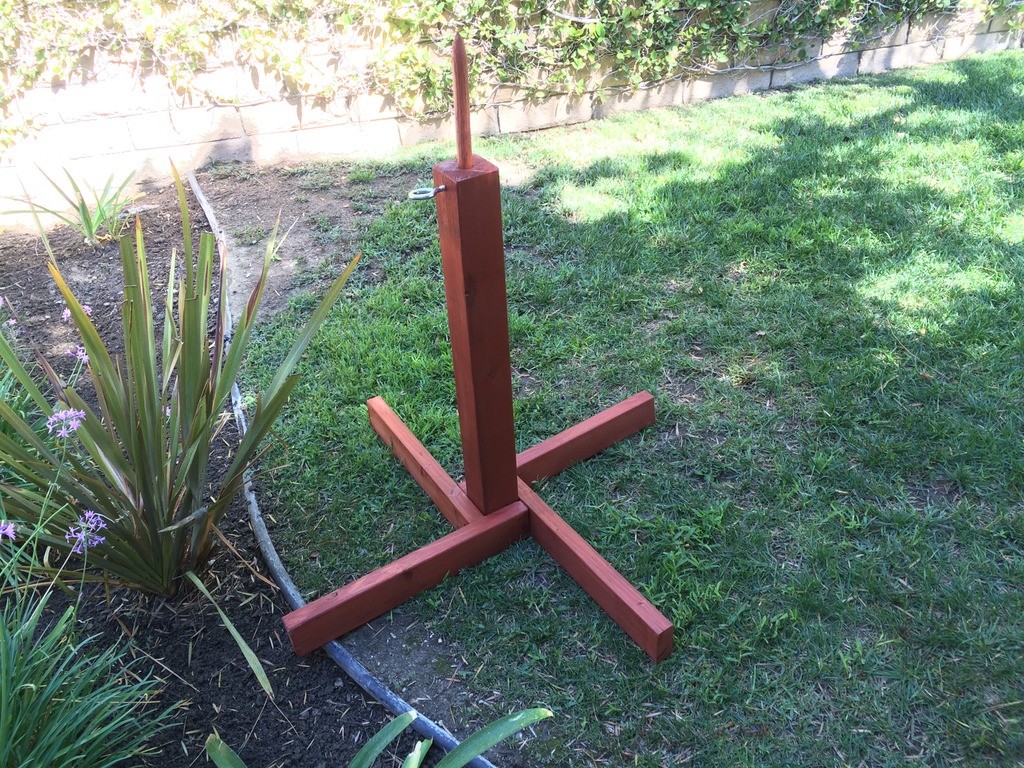
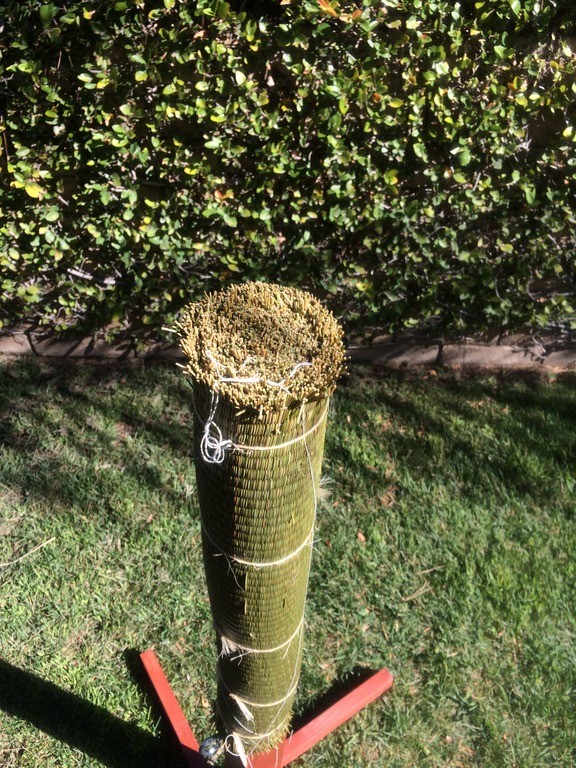

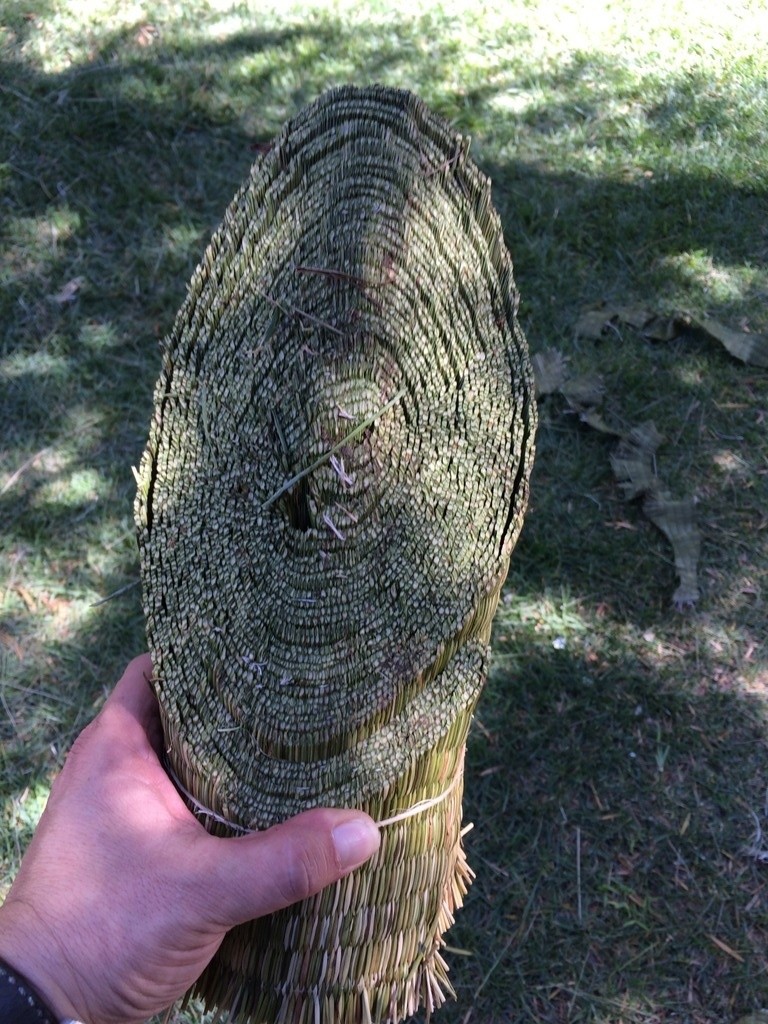
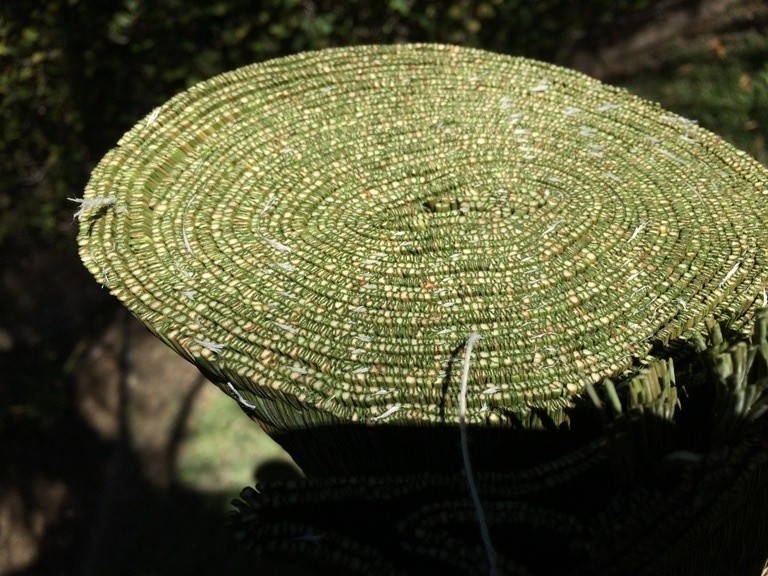
PS. Sorry about the bad aluminum dwarf knight from mexico... I got it for free when I helped move a friend.. So, I guess it is slightly better than nothing..
|
|
  |
 |
Vincent Le Chevalier

|
 Posted: Sun 20 Sep, 2015 4:43 am Post subject: Posted: Sun 20 Sep, 2015 4:43 am Post subject: |
 |
|
Hi Harry,
For your safety I'd advise that you do not try to start your sequence with that 'unsheathe' motion that you do here. At the slightest mistake, you'll slice your hand, or arm. This motion is also very much unlike what you would do if were actually drawing the sword from your side, so not worth the risk.
Until you have more training moving with the blade, perhaps focus on cutting without moving your feet. That spin you did at 1:53 frightened me!
In order to have a better control of your blade at the end of the cuts, try keeping your upper body upright, with a vertical spine. Leaning into cuts feels more powerful but isn't always, and it really puts you in a bad position for recovery.
Be safe and enjoy your blade!
Regards,
--
Vincent
Ensis Sub Caelo
|
|
   |
 |
Lancelot Chan
Industry Professional

|
|
   |
 |
|
J.-P. Rybak
Location: Munich, Bavaria, Germany Joined: 03 Jun 2012
Posts: 12
|
 Posted: Sun 20 Sep, 2015 6:34 am Post subject: Posted: Sun 20 Sep, 2015 6:34 am Post subject: |
 |
|
Greetings Harry,
first of all congratulations for obtaining an Albion and feeling good with it. It is definately a good start to have the right equipment from the beginning. Your tatami post looks sturdy as well!
After watching your video I deeply feel the urge to reply, to help you get better and at the most, safer in what you are doing.
I am training HEMA now for about 10-11 years in Munich, Germany and from time to time I get to cut up some tatamis, without it being a major part of my training. Despite that I hope to be able to give you some advice.
As you yet said, your form lacks. Heavily. Please don't take this offensively, as you wrote, it was your first time wielding a sword and I understand that. Take my post as advice and as a warning. This would go well not only to you but to every beginner in sword cutting, trained in martial arts or not.
First of all my warning, the way you are handling the sword is highly dangerous and you will be lucky not to harm yourself if you proceed like this. The reason you are able to cut through a double tatami mat comes mostly from the swords sharpness and the strength you are putting behind the strikes. Both these circumstances and the fact, that you are not able to control the sword proberly can lead to injuries. Please be conscious of that.
I will try to give you some tips on improving your form by analysing your video, but before that I'd like to give you some tips on the basics of sword handling. It is not possible to write down here all theory of swordsmanship, but I hope my tips will help you performing better. It is important for you to understand that without understanding and training the basics of this art, you won't get far.
Additionally to my tips I advice you to look up training videos to get startet or get into a group that trains HEMA, if that is a possibility where you live.
Well, let's get to some basics.
Stance:
For obtaining better control over your sword it is important to stand in a balanced way at every moment of your movement.
To get in a stable stance, stand with both feet shoulderwidth apart and make a normal step forward. Your front foot should point at your imaginary opponent and the other foot is at a 45° angle to the outside. Now lower your hips by about 10cm (3-4 inches). You should feel the stability this gives you in every direction.
To train your stance (at first without sword an hand) try to walk like that and try to end each step with the correct positioning of your feet.
Holding the sword:
Not much to change here from what I have seen in the video. At least for the beginning. If you get more comfortable holding the sword you will probably want to try to be more flexible as to where your left hand grips and how firm you grip the sword, but that is more a matter when it comes to other strikes than Oberhäue (upper cuts).
It is important not to grip the sword too firmly where it is not necessary. Gripping with too much force is tiring and makes you inflexible.
As an exercise, try to hold the sword by gripping only with the thumb and forefinger of your right hand and place the left hand so that it grips comfortably and rests against the pommel. You will see that this is enough to swing the sword an even deliver pretty hard strikes. Now close the fingers of the right hand. You should now have a grip that is sturdy but comfortable.
Before I get to the next point I recommend to watch this video showing a lecture by Peter Johnsson at the Arctic Fire Event 2013. From minute 51 onwards begins the part where he talks about sword dynamics. The understanding of what happens with a sword while striking and in the moment of impact is helpful for learning how an where to strike with a sword.
[urlhttp://www.ustream.tv/recorded/23590865][/url]
The first part of the video is also very interesting for somebody interested in swords and their manufacturing.
Striking with the sword:
Here, the two points from above, stance and holding the sword come together.
I will cover only how to deliver a Oberhau, a cut from your right or left shoulder downwards, for it is the most basic and intuitive cut, you will normally also learn at first when beginning HEMA training. For the other strikes (Unterhau/undercut, Mittelhau, strikes with the short edge, etc...) please consult manuals/trainers/videos.
Start exercising strikes in slow motion, so that you are able to correct yourself while moving and be able to be aware of all that happens with your body and the sword during the strike. Learn by observation of your errors.
To strike a Oberhau from the right shoulder, get into stance, so that your left foot stands ahead and your right foot behind.
Hold the sword so that it rests on your right shoulder, the blade at about a 45° angle and the crossguard about 5cm (2inch) under/away from your armpit.
Aim the strike at the left neck/breast area of your opponent (from the opponents point of view). The movement follows a straight line at about a 30° angle from a vertical line in the middle of the opponent.
The ending position of the right Oberhau is with your hands against and on the height of your left hip and the blade pointing towards the ground in the direction your left foot is pointing.
The moment you begin your strike, begin to make a step with your right foot forward. The moment of the impact of the strike is ideally the moment your foot contacts the ground again. Like this, you maintain balance, get additional impact and being in stance in the moment of the impact helps maintaining sword control and prevents overswinging.
A few things to consider while striking:
- Begin the strike with your left hand. The power of the strike comes for the greater part from the pivoting motion of your left hand around your right hand towards your right forearm. The right hand guides the sword into the designed direction, but the left hand brings the power.
Imagine your hands as a gravitational system. The right hand is a planet that moves around a sun (your body/shoulder)) and your left hand is like the planet's moon. This concept that I use to explain the kind of movement to beginners works with every strike.
- The striking movement is straight forward. Do not beginn your movement with a upward/backward haul.
- Never fully outstretch your arms. If you strike into fully outstreched arms you can injure your joints on impact and loose control of the sword. Considering a real fighting situation, outstretched joints can easily broken by levers or other techniques.
- Keep your blade parallel and in line of the striking direction. The strike may be perfectly executed, but with the edge outlined, your cutting ability of the strike is highly reduced.
- Try to hit the target with the section of the blade where the forward pivot point is (explained in Peter Johnsson's lecture video), this reduces shock and flexing of the blade.
In order to check for all the little things being correctly done it can be helpful to stop the the striking motion by "ins Hängen schlagen" (striking into hanging). That means you stop the motion at the moment the sword blade would impact your opponent. In that moment you are in a stance where your right foot has landed on the ground and is pointing towards your opponent. While starting with a 90° angle between your right forearm and the hilt of the sword when the sword rests on your shoulder, in the hanging position, your arms are in front to a little bit left to you with an angle of about 20-30° between your right forearm and the hilt. The tip of your sword pointing towards the opponent. When ending the strike with the hands beside your left hip, your left hand nearly touches your right forearm.
To strike from your left shoulder, it is the same, just start with the other foot forward and change the line of your strike to the right side of your opponent (opponents view).
I hope my descriptions will help you improving your technique. Please let me know if something is not understandable or I used the wrong words (I'm no native speaker). Please feel free to ask further questions, if you have some.
At last I will try to analyse your video and give some tips what you could improve.
I would recommend not to use double tatamis at at the beginning. Yes, you got to cut it, but not much by technique, but by brute force. There is a term in german fencing sources describing people that fight with too much much force as "Büffel" (buffalo) and the masters give concrete advice what to precisely do against such an opponent  . .
Let's get to the video, finally:
0:20
Start with the sword in the correct stance for the strike you want to do. For Oberhau that is from the shoulder. You can start in a "scabbard" position if you want, before getting into stance, but regarding the fact, that longswords where seldomly carried in a scabbard beside your hip, I would prefer to start with the sword in a "carrying" position on the shoulder or in the armpit.
0:21
-Do not swing your sword around like that with one hand. It might feel cool and handy, but just until you hack an ear of or cut the outer tendons of your foot.
strike beginning 0:22
- As a beginner, strike out of a standing position and out of the right stance. Try striking out of a walking approach when you are more experienced.
- Do not start the movement with a haul above your shoulder. Strike straight forward.
- You overswung and hit the ground with the tip of your sword. By making a step with the right leg, try to prevent that overswing at the end.
strike beginning 0:24
- Get back into stable stance before you do another strike.
- Make a step.
strike beginning 0:32
- You overswung by putting too much force into the strike turning your whole body. Try to bring extra punch into the strike by turning your right hip forward together with a proper step.
strike beginning 1:32
- You stand with your right foot forward when ending your strike without full control of your sword, you can easily hack with the tip into your foot. I hope you see how crucial stepping is in that situation.
strike beginning 1:40
- Imagine somebody standing left behind you. You have no control at all over your sword at this point. I have seen swords being flung out of the wielders hand right into people standing some meters away in similar situations.
strike beginning 1:55
- Get into the right mindset and be concious of how dangerous that situation is. You could have easily tripped and fallen into your sword.
All in all I hope you can grasp how dangerous it was for you what you did in your first try cutting with a sword.
I wouldn't recommend beginners to try cutting with a sharp sword before they are a few months into learning proper sword control, stance and techniques with blunt swords.
Please use my advice to get better technique, remind yourself of being aware of what you are doing and where your sword is in every moment of the action.
I hope this hole thing doesn't sound too harsh in parts, but I know for myself how it is to get super excited for a new thing.
Just keep yourself an others safe.
Best wishes,
JP
|
|
  |
 |
|
Harry D.
Location: Los Angeles Joined: 31 Aug 2015
Posts: 12
|
 Posted: Sun 20 Sep, 2015 6:32 pm Post subject: Posted: Sun 20 Sep, 2015 6:32 pm Post subject: |
 |
|
Vincent & Lancelot, Thanks for your replies ! I will follow your advice. I see that I have a long way to go..
J.-P. Rybak ,thanks for your training ! I really appreciate your investment in me ! I tried to follow your advice and recorded a new video... Here is a link to the new video... I know I am still far, but, at least I feel better control now... Thanks again for analyzing the video for me... That was really cool of you.. Bon Courage !!
https://youtu.be/LSbd35Xe_3k
https://www.youtube.com/watch?v=LSbd35Xe_3k&feature=youtu.be
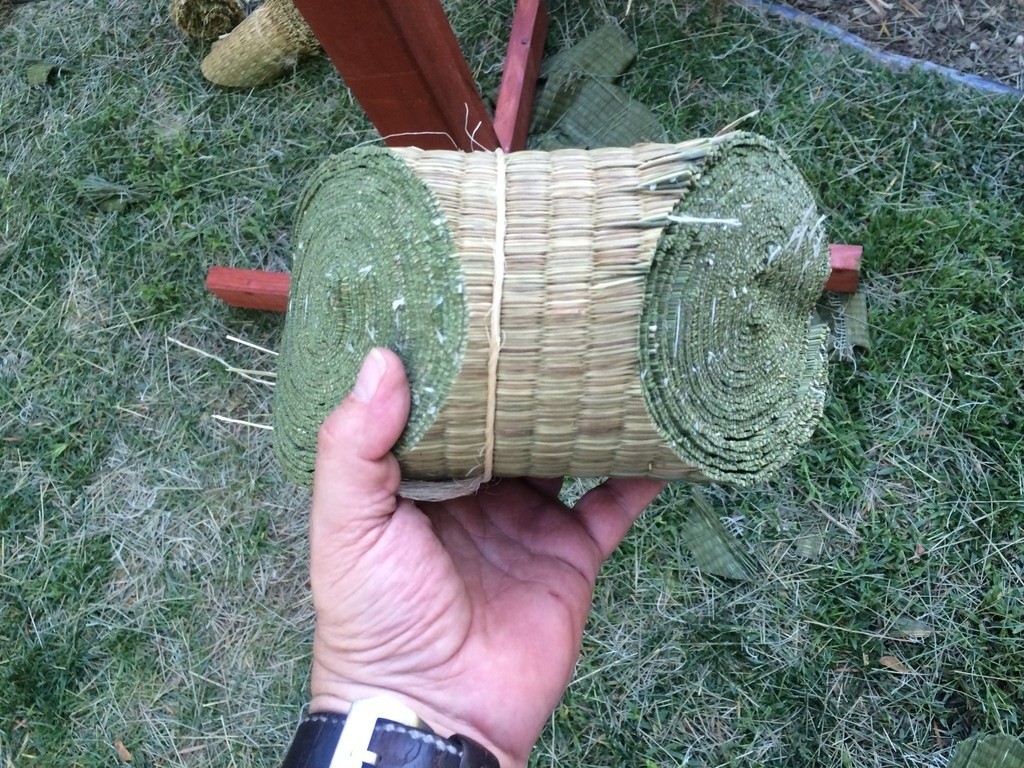
|
|
  |
 |
Hector A.

|
 Posted: Mon 21 Sep, 2015 12:36 am Post subject: Posted: Mon 21 Sep, 2015 12:36 am Post subject: |
 |
|
| Harry D. wrote: | Vincent & Lancelot, Thanks for your replies ! I will follow your advice. I see that I have a long way to go..
J.-P. Rybak ,thanks for your training ! I really appreciate your investment in me ! I tried to follow your advice and recorded a new video... Here is a link to the new video... I know I am still far, but, at least I feel better control now... Thanks again for analyzing the video for me... That was really cool of you.. Bon Courage !!
https://youtu.be/LSbd35Xe_3k
https://www.youtube.com/watch?v=LSbd35Xe_3k&feature=youtu.be
 |
Much much better! And safer!!!
I felt like you where fighting the urge to step forwards when you cut. DONT! That's how you secure your leg from downward cuts and it will ensure you flow into the cut.
Congratulations on your sword, you will need no other in your life  . .
|
|
  |
 |
|
J.-P. Rybak
Location: Munich, Bavaria, Germany Joined: 03 Jun 2012
Posts: 12
|
 Posted: Mon 21 Sep, 2015 4:01 am Post subject: Posted: Mon 21 Sep, 2015 4:01 am Post subject: |
 |
|
I am glad, I could help you Harry!
Your new approach definitely looks much better. Just one more advice to improve your stepping:
Before actually swinging all the way through, make some slow swings to take aim, stopping right before touching the tatami with the blade. Step forth and back with the right foot (when striking from the right) and maintain balance at all times of the movement. Exercise to make stepping and striking one movement, so that you eventually don't have to think about it.
Once your body gets used to all the new movements your muscles have to make while wielding a sword, I am sure you will further improve your overall form.
Have fun,
JP
|
|
  |
 |
Jean Thibodeau

|
 Posted: Mon 21 Sep, 2015 6:30 pm Post subject: Posted: Mon 21 Sep, 2015 6:30 pm Post subject: |
 |
|
Harry you have received some great advice already, but some of it is somewhat technical and can be difficult to understand until you get used to the technical language so I'll add some more general comments about what you might consider doing.
Firstly I would advise patience and not try or expect to learn good form instantly.
And yes you seem to be cutting the mats even without really good form, so put that aside for the moment because the goal should be to cut with the least effort possible.
Your main challenge is one of balance and not really knowing how or when to move your feet or how to combine your moving the sword with your arms with the rest of your body.
As mentioned by others you should avoid cocking the sword back before cutting: This may work with cutting mats, but in a sword fight this is telegraphing your attack and a good swordsman will see you coming a mile away !
Well, learning Longsword swordsmanship is a different challenge than just learning good cutting technique, although they are related.
On the safety issue remember that a sharp sword is like a gun that is always loaded, so be careful when trying anything new until you learn to always be aware of the position of your edges relative to any of your body parts. ( Or anyone close behind or next to you so that you don't accidentally cut them or worse )
I suggest getting a wooden waster or a good quality blunt training sword and practice any new moves or flourishes with them before doing anything " ambitious " with a sharp ! One clumsy move and you could easily cut yourself down to the bone more easily that you can cut a mat.
You are probably already aware of this Albion Maestro training sword, but having a practice sword that handles like a good period sword is better than using a wooden waster:
http://www.albion-swords.com/swords/albion/ma...enauer.htm
When you can handle a practice blunt and find that you never accidentally hit yourself with it, then you should be safe with a sharp as long as you always give it's sharp edges and point the respect they deserves.
It all comes down to being in control and always knowing the alignment of your edges relative to what you want to hit and what you don't want to hit.
Oh, and practice slowly, speed comes with repetition and smooth execution: You can't do it well fast if you can't first do it perfectly in slow motion ..... just my opinion ....  
You can easily give up your freedom. You have to fight hard to get it back!
|
|
  |
 |
Glen A Cleeton

|
 Posted: Tue 22 Sep, 2015 4:28 pm Post subject: Posted: Tue 22 Sep, 2015 4:28 pm Post subject: |
 |
|
Yes, safety first.
I abstained from cutting over this past weekend during a two day public event (doubting my own stability with a foot issue and lack of practice). We had two major oopsies after my caution about folk on both sides our tables. First a Dane axe that had been leaned against a tree that ended iup n my lap. Fortunately poll first but I did get a bruised knee. Second, a novice claiming sweaty hands helicoptering a wakazashi 30 feet away.
Nice sword 
Cheers
GC
|
|
  |
 |
Jean Thibodeau

|
 Posted: Wed 23 Sep, 2015 8:38 pm Post subject: Posted: Wed 23 Sep, 2015 8:38 pm Post subject: |
 |
|
| Glen A Cleeton wrote: | Yes, safety first.
I abstained from cutting over this past weekend during a two day public event (doubting my own stability with a foot issue and lack of practice). We had two major oopsies after my caution about folk on both sides our tables. First a Dane axe that had been leaned against a tree that ended iup n my lap. Fortunately poll first but I did get a bruised knee. Second, a novice claiming sweaty hands helicoptering a wakazashi 30 feet away.
Nice sword 
Cheers
GC |
Falling Dane Axe on lap seems a lot like a guillotine to me.   Lucky it fell in the best way possible consistent with having all your body parts mostly intact ! Lucky it fell in the best way possible consistent with having all your body parts mostly intact !
Helicoptering a wakazashi sounds even worse if it had ended up into a crowd of spectators !
How about juggling chain saws, it almost sound safer !
Now, accidents can always happen, even if one is very careful, but the danger is in becoming complacent and too casual with sharp things due to long familiarity.
Glad that it only turned out to be a funny story, but with a serious " EDGE " or " Point " ( Intended pun .....    ) )
You can easily give up your freedom. You have to fight hard to get it back!
|
|
  |
 |
Glen A Cleeton

|
 Posted: Thu 24 Sep, 2015 8:33 am Post subject: Posted: Thu 24 Sep, 2015 8:33 am Post subject: |
 |
|
Someone next to me had placed the axe against the tree and it was probably resting partly on that table as well.. Out of the corner of my eye, I saw it fall between that table and either just slipped by gravity or jostled by the table. It bounced down the back of a rack of swords, then my lap and knee to the ground (all I could exclaim was WTF) I had already warned of the public wandering into the crowd to swing swords around (old and young). All in all though, most are wary enough with parents and the aware around.
The day before, it was a tree away but even then I should have noted the potential.

After watching spears fall in past years, I always now stick the points in the bark and bow the shafts to ground the butts. Plus, moving them away from the tables and traffic.
The wakizashi sailed next door to the hawk tossing area. With my back to it, I missed the whole episode. I am moving back to the other side next year and hope for the best.
Yikes
GC
|
|
  |
 |
|
Harry D.
Location: Los Angeles Joined: 31 Aug 2015
Posts: 12
|
 Posted: Mon 28 Sep, 2015 7:01 pm Post subject: 3rd Double Tatami Omote Cutting Session Posted: Mon 28 Sep, 2015 7:01 pm Post subject: 3rd Double Tatami Omote Cutting Session |
 |
|
Hi Guys, thanks for all your advice and help. I have a lot to learn.. I made a third video of my attempt at double tatami mat cutting trying to follow all your recommendations. I am using a wide double grip like Ty Cobb and I can stop the Svante and accelerate it much faster, like a Katana. I am also following the advice of the left hand being the power hand and the right hand guiding. I am building snap and power faster that way...
It was a ton of fun.. Here is a new video.. I just bought a new Mateusz Sulowski XVIIIc Sword, so, I am excited to compare the two in the next cutting exercise. Bon Courage !
https://youtu.be/l4Aj1cuM91Y
https://www.youtube.com/watch?v=l4Aj1cuM91Y&feature=youtu.be
Last edited by Harry D. on Mon 28 Sep, 2015 11:30 pm; edited 1 time in total
|
|
  |
 |
Jean Thibodeau

|
 Posted: Mon 28 Sep, 2015 8:56 pm Post subject: Posted: Mon 28 Sep, 2015 8:56 pm Post subject: |
 |
|
Harry, your cutting does seem a little more in control and better at least in the sense of being safer with some more control.
By the way, I'm not personally in any way an expert in mat cutting but I did do about 4 years of Longsword training so I think I at least know how to move for drills, training and friendly bouting, so I'm more trained in fencing techniques than actual test cutting.
Now, maybe you should look at this video clip showing a bunch of people cutting, you should notice that a lot of the cutting is done in a very relaxed manner and even when the whole body is involved in the cut it is fluid and smooth and not jerky or overbalanced.
Note: A few of the people shown are very highly skilled instructors but there are also students with varying degrees of experience.
Some of the people cutting don't even move their feet and they get very smooth cuts, I think you are still somewhat overpowering your cuts but you are controlling the followthrough a bit better and more safely than before.
From what I can see in the video clip I link to below, and what I have read in other discussions about cutting, most of the cutting power comes from accelerating the sword to move fast and then letting the sword do the work for you with it's own momentum and avoiding pushing the sword through the cut.
Perfect edge alignment is also an important factor as well as having a good sharp edge on the sword, but even a relatively blunter edged sword will still cut if the alignment is good.
Here is the clip I mentioned: https://www.youtube.com/watch?v=ibubpiKM2Ic
Skallagrim's site has a lot of varied and interesting video clips worth looking into and is one of my favourite sites:
https://www.youtube.com/user/SkallagrimNilsson
Also some of the cuts are also shown in slow motion which may be helpful in analysing the sequence of motion from hands to hips to leg motion, when there is leg motion.
I would suggest that you try cutting without moving your legs as good practice ? Grip on the sword should be firm but relaxed and try minimum force even if it means that you don't always succeed in doing the cut, maybe ?
Trying to make every cut epic sort of puts you in a tense all or nothing mindset that can lead to over muscling the sword ?
In a way good cutting is like meditation in motion and good cutting has a very high degree mental attitude that is hard to explain ..... sort of like being " In the Zone ".
Oh, and congratulations on getting that Mateusz Sulowski XVIIIc sword.  
You can easily give up your freedom. You have to fight hard to get it back!
|
|
  |
 |
Craig Peters

|
 Posted: Mon 28 Sep, 2015 9:52 pm Post subject: Posted: Mon 28 Sep, 2015 9:52 pm Post subject: |
 |
|
Harry,
Steepen the angles of your cuts. A steeper angle will make it easier to deeply cleave through the target. You want your sword’s blade to be travelling along a line that’s about 80 degrees, like this: http://etc.usf.edu/clipart/32700/32738/c-angle80_32738_lg.gif.
|
|
  |
 |
|
Lukas MG
Industry Professional
|
 Posted: Wed 30 Sep, 2015 7:13 am Post subject: Posted: Wed 30 Sep, 2015 7:13 am Post subject: |
 |
|
As the others have pointed out, you really need to relax. One way that might make this easier is to stop using tatami for a while. A thick target like a double roll can subconsciously make you feel like you have to strike with a lot of force but the thing is, you don't. In order to realize that cutting should be smooth and effortless, I suggest you practice on some tetra packs or plastic bottles. Just by looking a lot less massive those might help you to lower the level of force you're swinging at, a level you are quite clearly no able to control. They are a lot cheaper, too.
Very nice choice in swords by the way... especially seeing how they are your first two 
Custom sword maker:
http://www.lukasmaestlegoer.com
|
|
   |
 |
|
Harry D.
Location: Los Angeles Joined: 31 Aug 2015
Posts: 12
|
 Posted: Mon 21 Dec, 2015 10:33 am Post subject: Svante Update Posted: Mon 21 Dec, 2015 10:33 am Post subject: Svante Update |
 |
|
Hey Sword Fans, I thought I would update you on my Svante. After tons of fun with Tatami, I sent my Svante back to Albion for the spa treatment (sharpening, satin, etc...) , then directly off to DBK for Scabbard Fitting. It is Brian's design meant to approximate something that the Viceroy could have carried at the time. The scabbard is extremely light, extremely well fitting, and thin. One side mimics the hollow grind blade, while the other is rounded for comfortable carry against your side. The Chape mimics the Svante Pommel. The sword will not move in the scabbard and will not slide out unless pulled. The light scabbard with the heavy Svante really decreases the overall carry weight. This scabbard really complements the Svante beautifully. I have a few iphone pics, but, you can see much better pics of the scabbard on the DBK Scabbard website or Brian's facebook page.
Look at that tight, precision fit. You can see the hollow grind blade outline inside the scabbard.
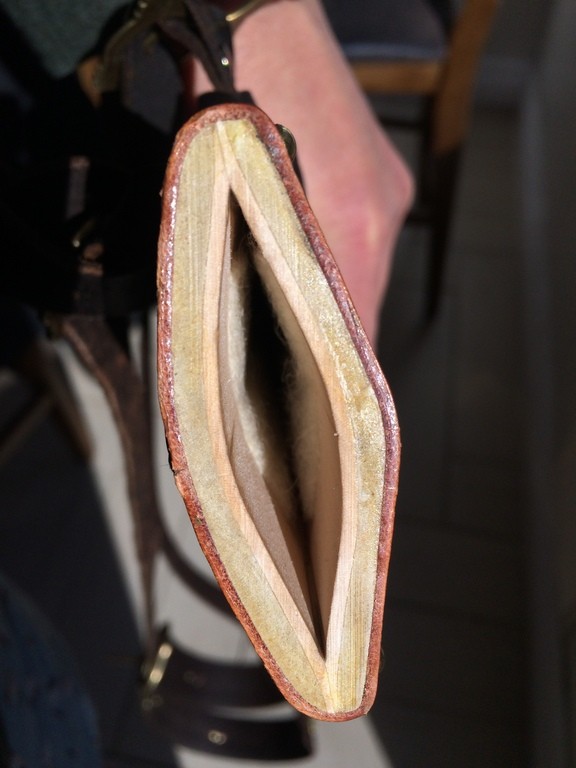
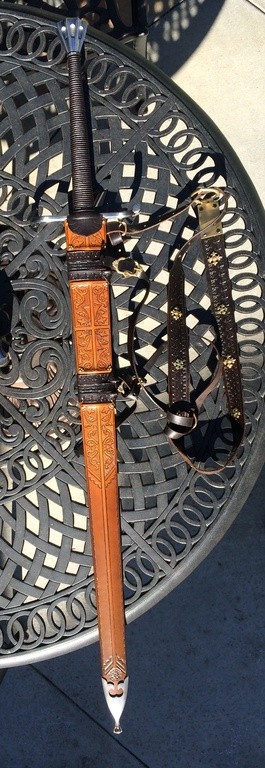
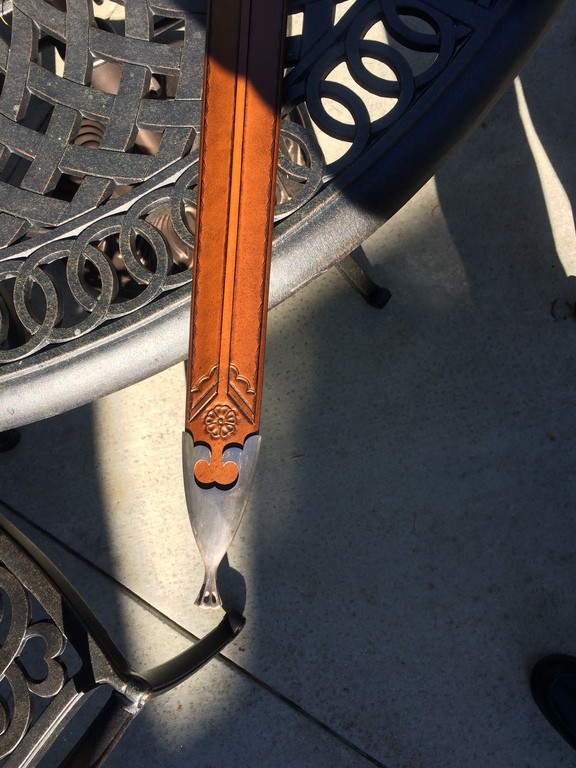
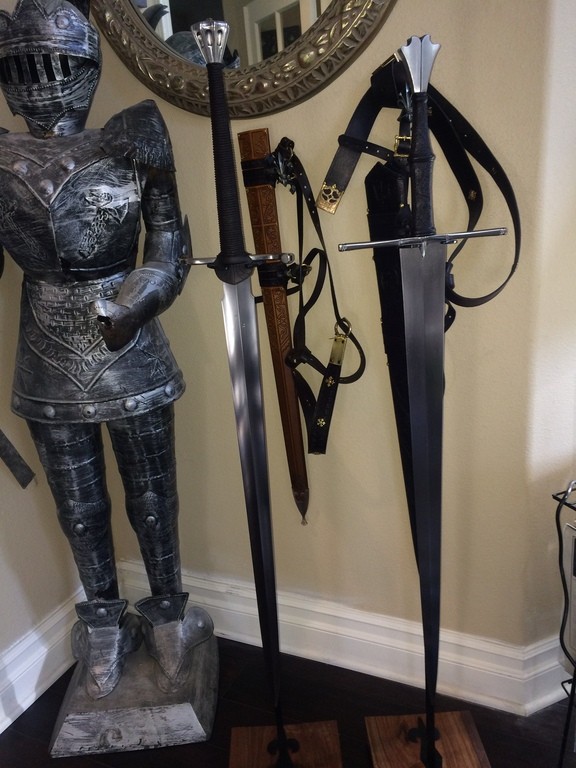
|
|
  |
 |
|
|
You cannot post new topics in this forum
You cannot reply to topics in this forum
You cannot edit your posts in this forum
You cannot delete your posts in this forum
You cannot vote in polls in this forum
You cannot attach files in this forum
You can download files in this forum
|
All contents © Copyright 2003-2025 myArmoury.com — All rights reserved
Discussion forums powered by phpBB © The phpBB Group
Switch to the Basic Low-bandwidth Version of the forum
|

